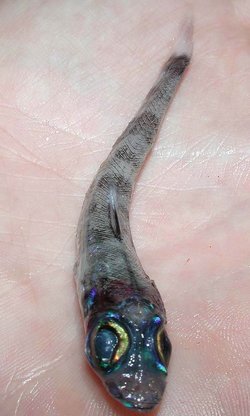Greeneye
|
|
| Greeneyes | ||||||||||
|---|---|---|---|---|---|---|---|---|---|---|
| | ||||||||||
| Scientific classification | ||||||||||
| ||||||||||
| Genera | ||||||||||
Greeneyes are deep-sea aulopiform marine fish of the small family Chlorophthalmidae. Thought to have a circumglobal distribution in tropical and temperate waters, the family contains just 19 species in three genera. The family name Chlorophthalmidae derives from the Greek words chloros meaning "green" and ophthalmos meaning "eye".
Some species are of interest to commercial and subsistence fisheries; the fish are made into fishmeal or sold fresh.
| Contents [hide] |
Physical description
Aptly named after their disproportionately large, iridescent eyes, Greeneyes are slender fish with slightly compressed bodies; the largest species, the Shortnose Greeneye (Chlorophthalmus agassizi) reaching a length of 40 centimetres (15.7 inches). Their heads are small with large jaws; coloration ranges from a yellowish to blackish brown, some species with cryptic blotches.
Their fins are simple and spineless; aside from their eyes, some species also have iridescent patches covering the head and body.
Behaviour and reproduction
Greeneyes are generally deepwater fish, found from 50 to about 1,000 metres. They seem to prefer the continental slopes and shelves, possibly forming schools. Greeneyes are known to primarily feed on benthic invertebrates, as well as pelagic crustaceans such as decapods and mysids.
Like many members of the Aulopiformes, Greeneyes are hermaphroditic; this is thought to be a great advantage in deep-sea habitats, where the chances of running into a compatible mate are uncertain. Young and larval Greeneyes are pelagic rather than benthic, staying within the upper levels of the water column. Hake are known predators of Greeneyes.
See also
External link
- FishBase entry on Chlorophthalmidae (http://www.fishbase.org/Summary/FamilySummary.cfm?ID=163)

